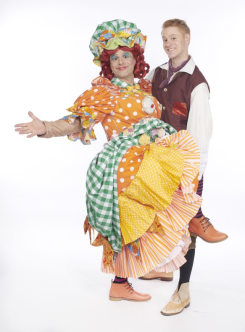
Dick Whittington at the Oxford Playhouse
Right then, hands up: who’s been to a pantomime this year?
For those who’ve never had to sit in a British theatre among a deafening audience of 6 year-olds, dodging penny sweets being hurled from the stage, while gamely shouting ‘He’s behind you!’ to Snow-White, or Aladdin, or Little Red Riding Hood, some explanation is needed. And my goodness, have I tried to explain this particular loud, brash, clunkily scripted, outrageously overacted, joyfully strewn with terrible puns and altogether much-loved piece of our Christmas tradition to bemused visitors from other countries down the years… never with the slightest success, unfortunately. You just have to be there, really.
Or not.

… and none more surprising than appearing in a pantomime.
But it only struck me recently (slow, that’s me) what an odd collection of stories makes up the pantomime repertoire. Fairy tales such as Cinderella and Sleeping Beauty, national legends like Robin Hood and Dick Whittington, all well and good… but – Robinson Crusoe? How did Daniel Defoe’s novel about shipwreck, isolation and the survival of the human spirit transmute into a raucous children’s entertainment, complete with slapstick, word play and (presumably – I haven’t seen it) pantomime dame and villain?
CARDIFF CASTLE
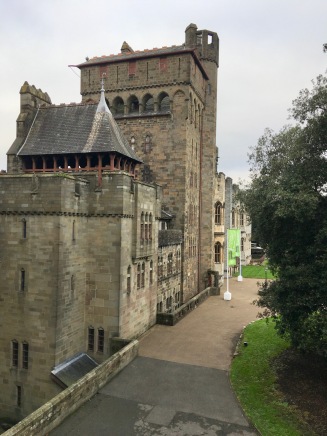
Cardiff Castle: transformed into a Gothic fairy tale by the 3rd Marquess of Bute
Now, I have a hunch that the answer lies in Cardiff Castle. (Oh, no it doesn’t, I hear you say. Oh yes it does, say I. Oh no it – hey, that’s quite enough.) In the mid 19th Century, the fabulously rich 3rd Marquess of Bute restored a section of this Norman ruin into a glorious expression of the Gothic Revival movement. Every wall, ceiling, door, window, fireplace and stairwell is beautifully painted, carved, moulded, decorated with marble, stone and plaster sculptures, furnished with fine wrought iron handles, knobs and railings, giving an overall impression of warmth and delight in craftsmanship. 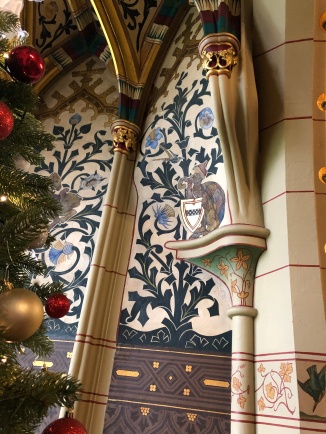 Above all it feels a very happy place, and nowhere is this more apparent than in the day nursery designed for the marquess’s four children. Half-way up the walls, an enormous frieze of hand-painted tiles shows dozens of storybook characters in one continuous, colourful narrative. And yes, you’ve guessed, the stories chosen are all (with the puzzling exception of Lady Godiva) ones that form classic pantomimes: Jack and the Beanstalk, Beauty and the Beast, Aladdin, St George and the Dragon, Robinson Crusoe.
Above all it feels a very happy place, and nowhere is this more apparent than in the day nursery designed for the marquess’s four children. Half-way up the walls, an enormous frieze of hand-painted tiles shows dozens of storybook characters in one continuous, colourful narrative. And yes, you’ve guessed, the stories chosen are all (with the puzzling exception of Lady Godiva) ones that form classic pantomimes: Jack and the Beanstalk, Beauty and the Beast, Aladdin, St George and the Dragon, Robinson Crusoe.
THE BLOSSOMING OF PANTOMIME
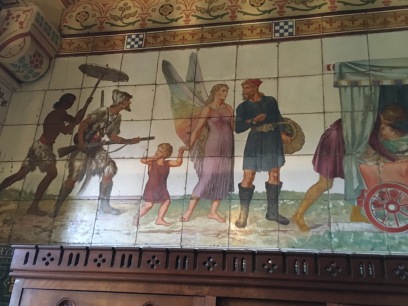
Robinson Crusoe on the trail of the Good Fairy. Er…
I doubt that this was an intentional homage to the genre on the part of the marquess: rather, the (7-league) boot is on the other foot. This mixture of tales from the Brothers Grimm, Charles Perrault, the Arabian Nights, folk legend and early novelist Daniel Defoe, is what constituted English mid-19th century children’s literature, just at the time when pantomime – around since Roman times – blossomed into the form we know today. (The Victorian playwrights and theatre managers probably balked at including Lady Godiva in their repertoire.)
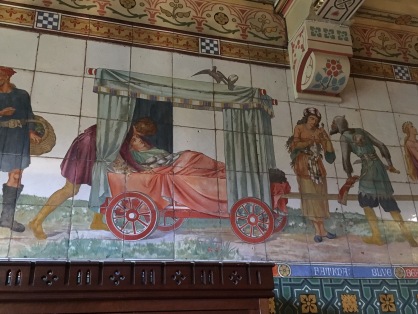
Zzzz… A peripatetic Sleeping Beauty
So pantomimes are all drawn from 19th century children’s stories – well, duh. There needs no Puss-in-Boots, come from the grave, my lord, to tell us this. But seeing the evidence so beautifully painted here made me grasp the point in a way I hadn’t before. What lucky children – as our slightly sardonic guide never ceased reminding us – to be brought up in such delightful surroundings.
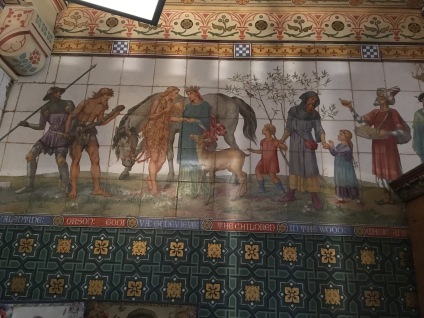
No pantomime – as yet – about Lady Godiva
Lucky or not (and the Bute family had its fair share of tragedy but that’s another story), we are all the richer for this stunning artistic heritage. Go and see Cardiff Castle if you can – the nursery is just one of a feast of glorious rooms open to the public.
(From an article originally published on Authors Electric Blog)